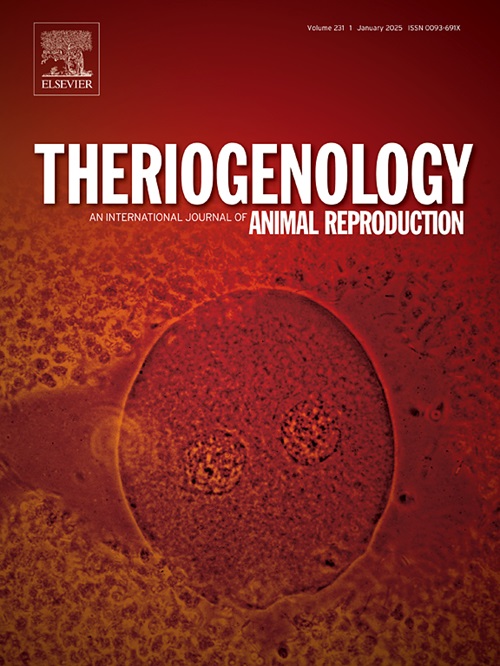交配后15天植入前羊驼胚胎的蛋白质组学分析揭示了雌二醇和皮质醇途径的特征
IF 2.4
2区 农林科学
Q3 REPRODUCTIVE BIOLOGY
引用次数: 0
摘要
南美洲骆驼(SACs)在安第斯经济中发挥着重要作用,但繁殖效率低下,特别是早期胚胎损失,对畜群生产力构成了重大挑战。本研究首次对着床前羊驼胚胎进行了蛋白质组学分析,为胚胎发育和着床的分子机制提供了新的见解。利用质谱技术,我们从交配后15天的羊驼胚胎中鉴定出510种蛋白质。功能富集分析揭示了与细胞骨架组织、代谢、胚胎伸长和着床相关的重要途径。检测了与妊娠延长、母体妊娠识别和类固醇生成相关的关键蛋白,包括角蛋白(KRT8、KRT18)、肌动蛋白(ACTG1)、膜联蛋白A2 (ANXA2),以及参与雌二醇和皮质醇生物合成的酶。检测到VEGFA、Nodal、NGF及其受体NTRK1的转录本,强调了它们在早期胚胎发育中的作用,并且与雌二醇和皮质醇合成相关的酶的表达表明这些激素在母胎交流中起关键作用。此外,还发现了包括PTGS2在内的参与前列腺素合成的蛋白,支持它们在受孕延长和着床中的作用。这项开创性的研究为了解羊驼胚胎在蛋白质组学水平上的发育提供了基础数据集,为改进SACs的生殖技术开辟了新的途径。这一发现揭示了羊驼胚胎发生的分子过程,为进一步研究优化骆驼辅助生殖技术提供了基础。本文章由计算机程序翻译,如有差异,请以英文原文为准。
Proteomic profiling of 15-day post-mating preimplantation alpaca embryos reveals estradiol and cortisol pathway signatures
South American camelids (SACs) play an important role in Andean economies, but reproductive inefficiencies, especially early embryonic losses, present significant challenges to herd productivity. This study provides the first proteomic analysis of preimplantation alpaca embryos, offering insights into the molecular mechanisms underlying embryo development and implantation. Using mass spectrometry, we identified 510 proteins in 15-day post-mating (dpm) alpaca embryos. Functional enrichment analysis revealed significant pathways related to cytoskeletal organization, metabolism, embryo elongation, and implantation. Key proteins associated with conceptus elongation, maternal recognition of pregnancy, and steroidogenesis were detected, including keratins (KRT8, KRT18), actin (ACTG1), annexin A2 (ANXA2), and enzymes involved in estradiol and cortisol biosynthesis. The transcripts of VEGFA, Nodal, NGF, and its receptor NTRK1 were detected, emphasizing their roles in early embryo development, and the expression of enzymes linked to estradiol and cortisol synthesis suggests that these hormones play key roles in maternal-fetal communication. Additionally, proteins involved in prostaglandin synthesis, including PTGS2, were identified, supporting their role in conceptus elongation and implantation. This pioneering study provides a foundational dataset for understanding alpaca embryo development at the proteomic level, opening new paths for improving reproductive technologies in SACs. The findings highlight the molecular processes driving alpaca embryogenesis and provide a basis for future research on optimizing assisted reproductive technologies in camelids.
求助全文
通过发布文献求助,成功后即可免费获取论文全文。
去求助
来源期刊

Theriogenology
农林科学-生殖生物学
CiteScore
5.50
自引率
14.30%
发文量
387
审稿时长
72 days
期刊介绍:
Theriogenology provides an international forum for researchers, clinicians, and industry professionals in animal reproductive biology. This acclaimed journal publishes articles on a wide range of topics in reproductive and developmental biology, of domestic mammal, avian, and aquatic species as well as wild species which are the object of veterinary care in research or conservation programs.
 求助内容:
求助内容: 应助结果提醒方式:
应助结果提醒方式:


